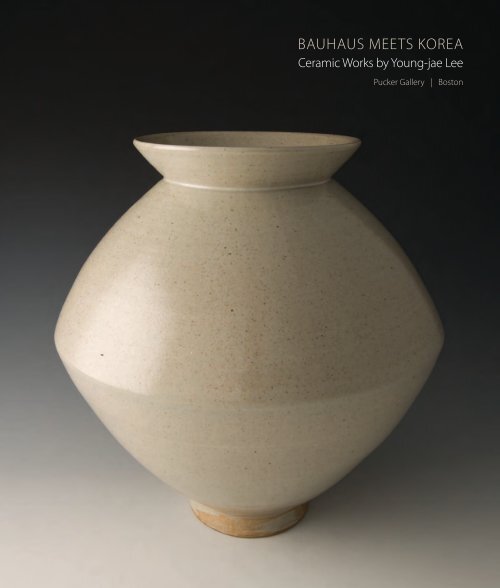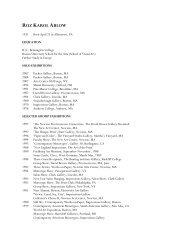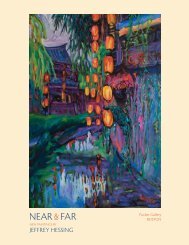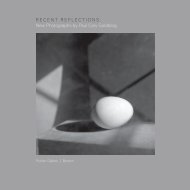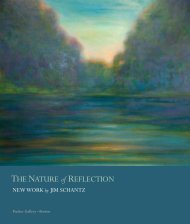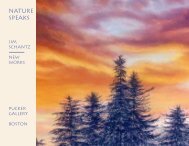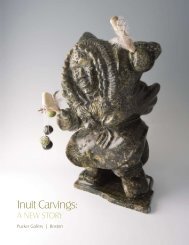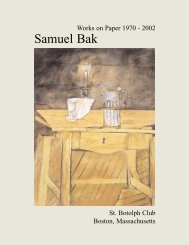Young-jae Lee 2012.pdf - Pucker Gallery
Young-jae Lee 2012.pdf - Pucker Gallery
Young-jae Lee 2012.pdf - Pucker Gallery
Create successful ePaper yourself
Turn your PDF publications into a flip-book with our unique Google optimized e-Paper software.
Bauhaus Meets Korea<br />
Ceramic Works by <strong>Young</strong>-<strong>jae</strong> <strong>Lee</strong><br />
<strong>Pucker</strong> <strong>Gallery</strong> | Boston
All works Are stonewAre.<br />
Large Bowl<br />
Light green celadon crackle glaze with engobe<br />
3 ½ x 19 ¼ x 19 ¼”<br />
YL95<br />
ON THE COVER:<br />
Spindle Vase<br />
Petalite oak ash glaze<br />
14 ¼ x 14 ¼ x 14 ¼”<br />
YL2
Bauhaus Meets Korea<br />
Ceramic Works by <strong>Young</strong>-<strong>jae</strong> <strong>Lee</strong><br />
a synergy of natural elegance and ergonomic perfection<br />
Shallow Bowl<br />
Petalite oak ash glaze<br />
3 x 8 ¼ x 8 ¼”<br />
YL12<br />
n spring 2001, I visited <strong>Young</strong>-<strong>jae</strong> <strong>Lee</strong>’s workshop “Margaretenhöhe”.<br />
We had bibimbap for lunch, which we ate from dishes<br />
that she created herself. When holding one of her bowls, I<br />
instantly felt its smooth surface, and appreciated how ergonomically<br />
it rested in my hands. after the meal, she put our<br />
bowls into the dishwasher. I was shocked, and asked myself: “how<br />
can one put such precious works of art into a common dishwashing<br />
machine?” she seemed to have sensed my apprehension and<br />
said: “these bowls are made to be used. Putting them into the dishwasher<br />
will make them even more beautiful, as the glaze becomes<br />
opaque like pebbles washed by running water. this adds a distinctive<br />
quality to the bowl’s surface.” ten years later, in the summer<br />
of 2011, I entered the exhibition halls of the asian art Museum in<br />
Berlin to see <strong>Young</strong>-<strong>jae</strong> <strong>Lee</strong>’s most recent solo exhibition. arranged<br />
in rows on a large square podium were 313 anthropomorphic cylindrical<br />
vases. By the cold light and the white walls of the museum<br />
space, they were transformed into pure art objects.<br />
the alleged contrast between a “daily use item” and a “high<br />
art” museum object is characteristic of <strong>Lee</strong>’s work. the exhibition<br />
of her works in the space of a museum or gallery facilitates one’s<br />
appreciation of their aesthetic features. using them on a daily basis<br />
GInGKo BILoBa (1815)<br />
This tree’s leaf, which from the East<br />
In my garden propagates,<br />
On its secret sense we feast<br />
like it elevates the sage.<br />
Is it but one being single<br />
Which as same itself divides?<br />
Are there two which choose to mingle<br />
So that one knows them as One?<br />
To reply to such a question,<br />
I have found a sense that’s true:<br />
Is it not my songs’ suggestion<br />
That I am one and also two?<br />
—Johann WoLfGanG von Goethe (1749-1832)<br />
affords the intimate experience of touching them, and thus elevates<br />
the appreciation of their functional properties. for <strong>Lee</strong>, who regards<br />
herself as a potter rather than an artist, striving for high aesthetic<br />
quality is important, but ultimately, such daily use ceramics are<br />
judged by their usefulness, which does not undermine, but rather<br />
emphasizes their aesthetic value.<br />
since 1987, <strong>Lee</strong> has been the head of the ceramics workshop<br />
“Margaretenhöhe”, which she assumed management of with a<br />
former colleague from university, hildegard eggemann. their<br />
workshop is located in the Zollverein Coalmine Industrial Complex<br />
(German: Zeche Zollverein), which is a former industrial area in the<br />
city of essen in north rhine-Westphalia, Germany. since the 1920s,<br />
a Bauhaus-inspired community of ceramic artists, goldsmiths and<br />
sculptors had lived and worked there. the Bauhaus tradition was<br />
discontinued after the war, but it was picked up again by <strong>Lee</strong> and<br />
her team from 1987 onward. together, they work in the spirit of the<br />
Bauhaus motto: “form follows function.” <strong>Lee</strong> designs a dish service for<br />
daily use (bowls, plates, tea pots, etc.) that is made by the members<br />
of her team and ensures their collective livelihoods. Besides serial<br />
production, <strong>Lee</strong> further expands on her creative techniques. the<br />
<strong>Pucker</strong> <strong>Gallery</strong> shows an overview of her masterpieces such as<br />
3
Shallow Bowl<br />
Petalite oak ash glaze<br />
3 x 8 ¼ x 8 ¼”<br />
YL16<br />
4<br />
cylindrical vases and spindle vases, which she has been refining<br />
since the late 1980s, and spinach bowls, which are her most<br />
recent creation.<br />
In the 1970s and the 1980s, <strong>Lee</strong> studied geometrical forms<br />
to develop her feeling for volume and formal outlines. she was<br />
inspired by Paul Cézanne’s (1839-1906) reduction of nature to the<br />
cylinder, the sphere and the cone. she focused on each of the<br />
three forms, one at a time, and introduced subtle variations. one of<br />
the forms that she developed is the cylindrical vase. unlike bowls,<br />
which are defined by their interior space, it is the silhouette of<br />
the cylindrical vase that makes them so attractive. <strong>Lee</strong>’s bold and<br />
earthy cylindrical vases teach us a new way of seeing by offering<br />
unusual proportions and unpretentious forms. Made in the form<br />
of a high, straight cylinder with a long neck and a moderate belly,<br />
they radiate a rustic, archaic presence. the freely executed design<br />
brushed with white slip onto the dark body endows them with<br />
a vibrant beauty. the strong grooves running around the body<br />
remind us of the process of the vase’s earthly origin, while the<br />
delicate silhouette resembles the fragile movement of a dancer.<br />
after having mastered single geometrical shapes and<br />
the technical skills of pottery making, <strong>Lee</strong> started to combine<br />
different geometrical forms from the late 1980s onward. Inspired<br />
by Constantin Brancusi’s (1876-1957) “colonnes sans fin” (columns<br />
without end), she combined geometrical modules on the vertical<br />
and created the first examples of her spindle vase form. It was<br />
especially Goethe’s poem on the Gingko tree, in which he talks<br />
about the oneness of two allegedly separate parts of one leaf,<br />
that released her creative energy to master this form, which she<br />
contends should not be interpreted as a copy of Korean moon<br />
jars (Korean: dal hangari). however, when considering the Korean<br />
roots of the artist, it is hard to resist a formal comparison between<br />
her spindle vases and the bulbous moon jar making tradition<br />
that became fashionable in eighteenth-century Joseon (1392-<br />
1910) Korea, when these jars were made for the royal court at the<br />
Bunwon kilns. as in the moon jars, <strong>Lee</strong>’s spindle vase is created by<br />
two separate bowls that are joined up like two arched palms of<br />
the hand. as a result, they create a spindle-shaped contour with an<br />
encased hollow space. as seen in the Korean traditional approach<br />
to moon jar forms, the foot and rim of <strong>Lee</strong>’s spindle vases are<br />
equally high, and the diameter of the foot is slightly smaller than<br />
that of the rim of the vessel. her vases however differ from the<br />
traditional model since she adds a third, widely open bowl-like shape
on the top of the two bowls, which constitutes the rim. Moreover, in<br />
contrast to the traditional Korean method, <strong>Lee</strong> points to the duality<br />
of the single vase by leaving visible the horizontal line that marks the<br />
border where the two bowls were joined. the purity of their form,<br />
the masterful craftsmanship, and their exquisite creamy or brightly<br />
colored glaze make the spindle vases one of the most distinguished<br />
masterpieces of <strong>Lee</strong>’s work.<br />
In recent years <strong>Lee</strong> has been preoccupied with the traditional<br />
Korean form of a multi-purpose bowl, commonly referred to as a tea<br />
bowl. her greatest challenge was the fact that the term tea bowl<br />
(Japanese: chawan) was coined by colonial Japanese art historians<br />
who determined the classification criteria by which its color and<br />
shape are judged. however, in Korean daily life, bowls function as<br />
versatile objects. one and the same bowl can be the receptacle<br />
for soup, rice, medicine and tea. traditionally, it was also used as an<br />
offering bowl. <strong>Lee</strong> recounts that her grandmother used to fill a bowl<br />
with water every morning to consecrate it to the local spirits who<br />
protected the household. In order to allude to this versatility, the<br />
artist prefers to call her tea bowls “spinach bowls”.<br />
holding one of <strong>Young</strong>-<strong>jae</strong> <strong>Lee</strong>’s spinach bowls in both hands<br />
is a delightful, multi-sensory experience which stimulates the eyes,<br />
hands and lips of the holder. a variation of hemispherical contours,<br />
monochrome and dotted glazes, serene and lively colors, small and<br />
large crackles turn each of them into an individualized personality.<br />
her spinach bowls are characterized by their simplicity and ease in<br />
the accomplishment of their form. each of the bowls creates its own<br />
vibrant inner space. some of them are slightly dented at the upper<br />
rim, which helps in holding the bowl with one’s fingers and serves as<br />
a drinking rim, while others feature a straight and smoothly rounded<br />
rim inviting the connoisseur to hold it to his lips.<br />
<strong>Lee</strong> describes the creation process of one and the same<br />
form as an act of devotion. each type of her works (plates, bowls,<br />
cylindrical vases, spindle vases, spinach bowls) minimally differs in<br />
shape. the repetitiveness of the form demands mental strength and<br />
humility from the artist. In order to keep her mental focus during the<br />
ceramics making process, <strong>Lee</strong> found guidance in the works by the<br />
16th-century spanish Carmelite nun and Christian mystic teresa of<br />
Ávila (1515-1582). teresa of Ávila’s inner attitude of devotion during<br />
spiritual exercises inspired <strong>Lee</strong> to keep her focus and to find serenity<br />
during her work. she also compares her work at the potter’s wheel<br />
with her grandmother’s devotional act of serving water to the<br />
household spirits.<br />
When looking at an installation of her work, the meditative<br />
moment of turning hundreds of bowls, plates and vases becomes<br />
visible at a glance. When installed in one room, one can see each<br />
vessel as a single individual piece, and as one part of a whole<br />
ensemble. Comparable to the individual in mass society, it shows the<br />
relation between single links and each link towards the group as a<br />
whole. Like a chamber music orchestra or choir, the reverberation of<br />
soft colors and shapes creates a wonderful harmony; nevertheless,<br />
each element is unique and separate.<br />
<strong>Young</strong>-<strong>jae</strong> <strong>Lee</strong> is one of the most acclaimed ceramic artists in<br />
Germany. numerous exhibitions, publications and prizes, including<br />
the Bavarian state Prize, are testament to this claim. natural<br />
elegance, which is the essence of Korean art, combined with<br />
German craftsmanship and modern firing and glaze techniques are<br />
the distinguishing features of her oeuvre. those who truly want to<br />
understand her work should not only look at her vessels but hold a<br />
plate, bowl or vase in both hands to experience its haptic dimension.<br />
once you feel and touch <strong>Young</strong>-<strong>jae</strong> <strong>Lee</strong>’s ceramic works, you will<br />
experience true aesthetic beauty and organic perfection.<br />
—MaYa KerstIn stILLer<br />
Maya Stiller received her Ph.D. in East Asian Art History from Freie Universitaet Berlin<br />
in 2008. Since then, she has become affiliated with UCLA, where she researches<br />
how pilgrimage-related visual and written material have informed Korean cultural<br />
identity.<br />
BIBLIoGraPhY<br />
<strong>Young</strong>-<strong>jae</strong> <strong>Lee</strong> – Spindelvasen [<strong>Young</strong>-<strong>jae</strong> <strong>Lee</strong> – Spindle Vases], ed. reinhold Baumstark. exh. Cat. Pinakothek der Moderne. Munich: hatje Cantz, 2008.<br />
Formen aus der Erde [Forms from the Earth], ed. Johannes Janssen. exh. Cat. aLtana Kulturstiftung im sinclair-haus. Cologne: Wienand, 2010.<br />
Jungmann, Burglind. Life in Ceramics: Five Contemporary Korean Artists. Los angeles, Calif.: fowler Museum at uCLa, 2010.<br />
rahman-steinert, Uta. Behältnisse - Installationen von <strong>Young</strong>-<strong>jae</strong> <strong>Lee</strong>: 313 Gefäße [Receptacles – Installations by <strong>Young</strong>-<strong>jae</strong> <strong>Lee</strong>: 313 Vessels]. exh. Cat. asian art Museum,<br />
Berlin state Museums, 2011.<br />
<strong>Young</strong>-Jae <strong>Lee</strong>. 1111 Schalen [<strong>Young</strong>-<strong>jae</strong> <strong>Lee</strong>. 1111 Bowls], ed. reinhold Baumstark. exh. Cat. Pinakothek der Moderne. Munich: hatje Cantz, 2006.<br />
5
Pointed Bowl<br />
Feldspathic glaze<br />
4 ½ x 7 x 7”<br />
YL15<br />
6<br />
Pointed Bowl<br />
Feldspathic glaze<br />
4 ½ x 7 x 7”<br />
YL22<br />
Pointed Bowl<br />
Wollastonite-Feldspathic glaze<br />
3 ¾ x 7 ¾ x 7 ¾”<br />
YL18
Spinach Bowl<br />
Kreide-Feldspathic glaze<br />
3 ¼ x 4 ½ x 4 ½”<br />
YL104<br />
Spinach Bowl<br />
Kreide-Feldspathic glaze<br />
3 ¼ x 4 ¾ x 4 ¾”<br />
YL105<br />
Spinach Bowl<br />
Kreide-Feldspathic glaze<br />
3 ¼ x 4 ½ x 4 ½”<br />
YL106<br />
7<br />
Large Bowl<br />
White crackle glaze with<br />
engobe<br />
3 ½ x 18 ¾ x 18 ¾”<br />
YL92
8<br />
Cylindrical Vase<br />
Petalite oak ash glaze with engobe<br />
14 x 5 ½ x 5 ½”<br />
YL6<br />
Spinach Bowl<br />
Talc-Feldspathic glaze<br />
3 x 5 ¾ x 5 ¾”<br />
YL188<br />
Cylindrical Vase<br />
Petalite oak ash glaze with engobe<br />
15 ¼ x 5 x 5”<br />
YL7<br />
Spinach Bowl<br />
Talc-Feldspathic glaze<br />
3 x 5 ½ x 5 ½”<br />
YL189<br />
Cylindrical Vase<br />
Petalite oak ash glaze with engobe<br />
14 ¼ x 5 ¼ x 5 ¼”<br />
YL8<br />
Spinach Bowl<br />
Talc-Feldspathic glaze<br />
3 ¼ x 5 ½ x 5 ½”<br />
YL190
Spinach Bowl<br />
Kreide-Feldspathic glaze<br />
3 ¼ x 4 ¾ x 4 ¾”<br />
YL107<br />
Spinach Bowl<br />
Kreide-Feldspathic glaze<br />
3 ½ x 4 ¾ x 4 ½”<br />
YL110<br />
Spinach Bowl<br />
Kreide-Feldspathic glaze<br />
3 ¼ x 5 x 4 ¾”<br />
YL113<br />
Spinach Bowl<br />
Kreide-Feldspathic glaze<br />
3 ½ x 4 ½ x 4 ¼”<br />
YL108<br />
Spinach Bowl<br />
Kreide-Feldspathic glaze<br />
3 ½ x 4 ½ x 4 ½”<br />
YL111<br />
Spinach Bowl<br />
Kreide-Feldspathic glaze<br />
3 ¼ x 4 ½ x 4 ½”<br />
YL114<br />
Spinach Bowl<br />
Kreide-Feldspathic glaze<br />
3 ½ x 4 ¾ x 4 ¾”<br />
YL109<br />
Spinach Bowl<br />
Kreide-Feldspathic glaze<br />
3 ¼ x 5 x 5”<br />
YL112<br />
Spinach Bowl<br />
Kreide-Feldspathic glaze<br />
3 ½ x 4 ½ x 4 ½”<br />
YL115<br />
9
10<br />
Spinach Bowl<br />
Kreide-Feldspathic glaze<br />
4 x 5 ½ x 5 ½”<br />
YL116<br />
Spinach Bowl<br />
Kreide-Feldspathic glaze<br />
3 x 5 ¼ x 5 ¼”<br />
YL119<br />
Spinach Bowl<br />
Kreide-Feldspathic glaze<br />
3 ½ x 4 ¾ x 4 ¾”<br />
YL122<br />
Spinach Bowl<br />
Kreide-Feldspathic glaze<br />
3 ¾ x 4 ¾ x 4 ¾”<br />
YL117<br />
Spinach Bowl<br />
Kreide-Feldspathic glaze<br />
3 ¼ x 4 ¾ x 4 ¾”<br />
YL120<br />
Spinach Bowl<br />
Kreide-Feldspathic glaze<br />
3 ¾ x 4 ¾ x 4 ¾”<br />
YL123<br />
Spinach Bowl<br />
Kreide-Feldspathic glaze<br />
3 x 5 ¼ x 5 ¼”<br />
YL118<br />
Spinach Bowl<br />
Kreide-Feldspathic glaze<br />
3 ¼ x 4 ¾ x 4 ¾”<br />
YL121<br />
Spinach Bowl<br />
Kreide-Feldspathic glaze<br />
3 ½ x 4 ¼ x 4 ¼”<br />
YL124
Spindle Vase<br />
Petalite oak ash glaze<br />
13 ½ x 14 ½ x 14 ½”<br />
YL3<br />
11
Bowl<br />
Petalite oak ash glaze<br />
4 ½ x 5 x 5”<br />
YL19<br />
12<br />
Spindle Vase<br />
Petalite oak ash glaze<br />
13 ¼ x 13 x 13”<br />
YL4<br />
Spinach Bowl<br />
Talc-Feldspathic glaze<br />
3 ¾ x 4 ¾ x 4 ¾”<br />
YL191<br />
Spinach Bowl<br />
Talc-Feldspathic glaze<br />
3 ½ x 5 ½ x 5 ½”<br />
YL187
Spinach Bowl<br />
Kreide-Feldspathic glaze<br />
4 x 5 ¼ x 5 ¼”<br />
YL125<br />
Spinach Bowl<br />
Feldspathic glaze<br />
3 ¼ x 4 ½ x 4 ½”<br />
YL128<br />
Spinach Bowl<br />
Feldspathic glaze<br />
3 ½ x 4 ¾ x 4 ¾”<br />
YL131<br />
Spinach Bowl<br />
Kreide-Feldspathic glaze<br />
3 ¼ x 4 ¾ x 4 ¾”<br />
YL126<br />
Spinach Bowl<br />
Feldspathic glaze<br />
3 ¾ x 4 x 4”<br />
YL129<br />
Spinach Bowl<br />
Feldspathic glaze<br />
2 ¾ x 5 ¼ x 5 ¼”<br />
YL132<br />
Spinach Bowl<br />
Feldspathic glaze<br />
3 ¼ x 4 ½ x 4 ½”<br />
YL127<br />
Spinach Bowl<br />
Feldspathic glaze<br />
3 ¾ x 4 ¾ x 4 ¾”<br />
YL130<br />
Spinach Bowl<br />
Feldspathic glaze<br />
3 ½ x 4 ½ x 4 ½”<br />
YL133<br />
13
Spinach Bowl<br />
Feldspathic glaze<br />
4 x 4 ¼ x 4 ¼”<br />
YL134<br />
Spinach Bowl<br />
Feldspathic glaze<br />
3 ½ x 4 ¾ x 4 ¾”<br />
YL137<br />
Spinach Bowl<br />
Feldspathic glaze<br />
3 x 5 ¼ x 5 ¼”<br />
YL140<br />
14<br />
Spinach Bowl<br />
Feldspathic glaze<br />
3 x 4 ½ x 4 ½”<br />
YL135<br />
Spinach Bowl<br />
Feldspathic glaze<br />
3 ¾ x 4 ¾ x 4 ¾”<br />
YL138<br />
Spinach Bowl<br />
Spodumene-Feldspathic glaze<br />
3 x 5 x 5”<br />
YL141<br />
Spinach Bowl<br />
Feldspathic glaze<br />
3 ¼ x 4 ¼ x 4 ¼”<br />
YL136<br />
Spinach Bowl<br />
Feldspathic glaze<br />
3 ¾ x 4 ½ x 4 ½”<br />
YL139<br />
Spinach Bowl<br />
Spodumene-Feldspathic glaze<br />
3 ¾ x 4 ¾ x 4 ¾”<br />
YL142
Spindle Vase<br />
Petalite oak ash glaze<br />
16 ½ x 12 ¾ x 12 ¾”<br />
YL5<br />
15
16<br />
Spindle Vase<br />
“White Rose” Petalite-Feldspathic glaze<br />
11 x 15 ½ x 15 ½”<br />
YL99
Pointed Bowl<br />
Petalite oak ash glaze<br />
4 ½ x 7 x 7”<br />
YL13<br />
17<br />
Large Bowl<br />
Light green celadon crackle glaze<br />
4 ¼ x 19 x 19”<br />
YL93<br />
Spinach Bowl<br />
Feldspathic glaze<br />
3 ½ x 5 x 5”<br />
YL209
18<br />
Spinach Bowl<br />
Spodumene-Feldspathic glaze<br />
3 ½ x 4 ¾ x 4 ¾”<br />
YL152<br />
Spinach Bowl<br />
Spodumene-Feldspathic glaze<br />
3 x 5 x 5”<br />
YL155<br />
Spinach Bowl<br />
Barium-Feldspathic glaze<br />
3 ¼ x 5 x 5”<br />
YL158<br />
Spinach Bowl<br />
Spodumene-Feldspathic glaze<br />
3 ¾ x 5 x 5”<br />
YL153<br />
Spinach Bowl<br />
Spodumene-Feldspathic glaze<br />
3 ¼ x 4 ¾ x 4 ¾”<br />
YL156<br />
Spinach Bowl<br />
Barium-Feldspathic glaze<br />
3 x 5 ¼ x 5 ¼”<br />
YL159<br />
Spinach Bowl<br />
Spodumene-Feldspathic glaze<br />
3 ½ x 5 x 5”<br />
YL154<br />
Spinach Bowl<br />
Barium-Feldspathic glaze<br />
3 ¼ x 5 x 5”<br />
YL157<br />
Spinach Bowl<br />
Barium-Feldspathic glaze<br />
3 ½ x 5 ½ x 5 ½”<br />
YL160
19<br />
Large Bowl<br />
White crackle glaze with engobe<br />
3 ½ x 19 x 19”<br />
YL98
Shallow Bowl<br />
Feldspathic glaze<br />
2 ½ x 8 ¼ x 8 ¼”<br />
YL17<br />
20<br />
Spinach Bowl<br />
Talc-Feldspathic glaze<br />
3 x 5 ¾ x 5 ¾”<br />
YL185<br />
Spinach Bowl<br />
Talc-Feldspathic glaze<br />
3 ¼ x 4 ¾ x 4 ¾”<br />
YL192<br />
Spinach Bowl<br />
Talc-Feldspathic glaze<br />
3 x 5 ¾ x 5 ¾”<br />
YL186<br />
Spinach Bowl<br />
Talc-Feldspathic glaze<br />
3 ¾ x 4 ¾ x 4 ¾”<br />
YL191<br />
Shallow Bowl<br />
Feldspathic glaze<br />
2 ¾ x 8 ¾ x 8 ¾”<br />
YL11<br />
Spinach Bowl<br />
Talc-Feldspathic glaze<br />
3 x 5 ¾ x 5 ¾”<br />
YL193<br />
Spinach Bowl<br />
Talc-Feldspathic glaze<br />
3 ½ x 5 ½ x 5 ½”<br />
YL187
Spinach Bowl<br />
Spodumene-Feldspathic glaze<br />
3 ¼ x 5 x 5”<br />
YL143<br />
Spinach Bowl<br />
Spodumene-Feldspathic glaze<br />
3 x 5 x 5”<br />
YL146<br />
Spinach Bowl<br />
Spodumene-Feldspathic glaze<br />
3 ¼ x 4 ½ x 4 ½”<br />
YL149<br />
Spinach Bowl<br />
Spodumene-Feldspathic glaze<br />
3 ½ x 5 x 5”<br />
YL144<br />
Spinach Bowl<br />
Spodumene-Feldspathic glaze<br />
3 ¾ x 5 x 5”<br />
YL147<br />
Spinach Bowl<br />
Spodumene-Feldspathic glaze<br />
3 x 5 ½ x 5 ½”<br />
YL150<br />
21<br />
Spinach Bowl<br />
Spodumene-Feldspathic glaze<br />
3 ¼ x 4 ¾ x 4 ¾”<br />
YL145<br />
Spinach Bowl<br />
Spodumene-Feldspathic glaze<br />
3 ½ x 4 ½ x 4 ½”<br />
YL148<br />
Spinach Bowl<br />
Spodumene-Feldspathic glaze<br />
3 x 5 ¾ x 5 ¾”<br />
YL151
22<br />
Spinach Bowl<br />
Barium-Feldspathic glaze<br />
3 x 5 ¾ x 5 ¾”<br />
YL161<br />
Spinach Bowl<br />
Barium-Feldspathic glaze<br />
3 ½ x 5 ¼ x 5 ¼”<br />
YL164<br />
Spinach Bowl<br />
Barium-Feldspathic glaze<br />
3 ¼ x 5 x 5”<br />
YL167<br />
Spinach Bowl<br />
Barium-Feldspathic glaze<br />
3 ½ x 5 x 5”<br />
YL162<br />
Spinach Bowl<br />
Barium-Feldspathic glaze<br />
3 ½ x 4 ¾ x 4 ¾”<br />
YL165<br />
Spinach Bowl<br />
Barium-Feldspathic glaze<br />
3 x 6 x 6”<br />
YL168<br />
Spinach Bowl<br />
Barium-Feldspathic glaze<br />
3 ½ x 5 x 5”<br />
YL163<br />
Spinach Bowl<br />
Barium-Feldspathic glaze<br />
3 x 4 ½ x 4 ½”<br />
YL166<br />
Spinach Bowl<br />
Barium-Feldspathic glaze<br />
3 x 5 ¾ x 5 ¾”<br />
YL169
Spinach Bowl<br />
Talc-Feldspathic glaze<br />
3 ½ x 5 x 5”<br />
YL194<br />
Spinach Bowl<br />
Feldspathic glaze<br />
3 x 5 x 5”<br />
YL195<br />
Spinach Bowl<br />
Feldspathic glaze<br />
3 ¾ x 4 ½ x 4 ½”<br />
YL196<br />
23<br />
Spindle Vase<br />
Petalite Feldspathic glaze<br />
13 ¼ x 15 x 15”<br />
YL100
Spindle Vase<br />
Feldspathic glaze<br />
13 ½ x 15 ½ x 15 ½”<br />
YL101<br />
Spinach Bowl<br />
Feldspathic glaze<br />
3 x 5 x 5”<br />
YL197<br />
24<br />
Spinach Bowl<br />
Feldspathic glaze<br />
3 ¾ x 4 ¾ x 4 ¾”<br />
YL198<br />
Spinach Bowl<br />
Feldspathic glaze<br />
3 ¼ x 4 ¾ x 4 ¾”<br />
YL199
Spinach Bowl<br />
Barium-Feldspathic glaze<br />
3 ½ x 5 ½ x 5 ½”<br />
YL170<br />
Spinach Bowl<br />
Barium-Feldspathic glaze<br />
3 x 5 ¼ x 5 ¼”<br />
YL173<br />
Spinach Bowl<br />
Barium-Feldspathic glaze<br />
3 ½ x 5 x 5”<br />
YL176<br />
Spinach Bowl<br />
Barium-Feldspathic glaze<br />
3 x 5 ½ x 5 ½”<br />
YL171<br />
Spinach Bowl<br />
Barium-Feldspathic glaze<br />
3 ¾ x 5 x 5”<br />
YL174<br />
Spinach Bowl<br />
Barium- Feldspathic glaze<br />
3 ½ x 5 ¼ x 5 ¼”<br />
YL177<br />
Spinach Bowl<br />
Barium-Feldspathic glaze<br />
3 ½ x 5 ¼ x 5 ¼”<br />
YL172<br />
Spinach Bowl<br />
Barium-Feldspathic glaze<br />
3 ¾ x 5 x 5”<br />
YL175<br />
Spinach Bowl<br />
Barium-Feldspathic glaze<br />
3 ½ x 5 ½ x 5 ½”<br />
YL178<br />
25
Spinach Bowl<br />
Feldspathic glaze<br />
3 ¾ x 4 ¾ x 4 ¾”<br />
YL179<br />
26<br />
Spinach Bowl<br />
Wollastonite-Feldspathic glaze<br />
4 x 5 x 5”<br />
YL182<br />
Bowl<br />
Feldspathic glaze with engobe<br />
3 ¼ x 5 x 5”<br />
YL23<br />
Spinach Bowl<br />
Wollastonite-Feldspathic glaze<br />
3 ¾ x 5 ¾ x 5 ¾”<br />
YL180<br />
Spinach Bowl<br />
Wollastonite-Feldspathic glaze<br />
3 ¾ x 5 x 5”<br />
YL183<br />
Bowl<br />
Feldspathic glaze with engobe<br />
3 ½ x 5 x 5”<br />
YL24<br />
Spinach Bowl<br />
Wollastonite-Feldspathic glaze<br />
3 x 5 ½ x 5 ½”<br />
YL181<br />
Spinach Bowl<br />
Wollastonite-Feldspathic glaze<br />
3 x 4 ½ x 4 ½”<br />
YL184<br />
Bowl<br />
Feldspathic glaze with engobe<br />
3 ½ x 4 ½ x 4 ½”<br />
YL27
Spinach Bowl<br />
Feldspathic glaze<br />
3 ¼ x 4 ½ x 4 ½”<br />
YL206<br />
Spinach Bowl<br />
Feldspathic glaze<br />
3 ¼ x 5 x 5”<br />
YL207<br />
Spinach Bowl<br />
Feldspathic glaze<br />
3 ¼ x 4 ¾ x 4 ¾”<br />
YL208<br />
27<br />
Spindle Vase<br />
Dolomite-Feldspathic glaze<br />
13 ½ x 13 ¼ x 13 ¼”<br />
YL102
Spinach Bowl<br />
Feldspathic glaze<br />
3 x 5 ¼ x 5 ¼”<br />
YL200<br />
28<br />
Spindle Vase<br />
Strontium-Feldspathic glaze<br />
13 ½ x 15 ¼ x 15 ¼”<br />
YL103<br />
Spinach Bowl<br />
Feldspathic glaze<br />
3 ¾ x 5 x 5”<br />
YL201<br />
Spinach Bowl<br />
Feldspathic glaze<br />
3 ¼ x 4 ¾ x 4 ¾”<br />
YL202
Spinach Bowl<br />
Feldspathic glaze<br />
3 ½ x 4 ½ x 4 ½”<br />
YL203<br />
Spinach Bowl<br />
Feldspathic glaze<br />
3 ½ x 5 x 5”<br />
YL204<br />
Spinach Bowl<br />
Feldspathic glaze<br />
3 ¾ x 4 ¾ x 4 ¾”<br />
YL205<br />
29<br />
Large Bowl<br />
White crackle glaze<br />
with engobe<br />
3 ½ x 21 x 21”<br />
YL94
30<br />
BIoGraPhY<br />
<strong>Young</strong>-<strong>jae</strong> <strong>Lee</strong><br />
1951 Born in seoul, south Korea<br />
1968-1972 studied at academy of fine arts in seoul<br />
1972-1973 Internship with Christine tappermann in<br />
Wallrabenstein, Germany<br />
1973-1978 studied ceramics at the Münster university of applied<br />
sciences, Münster, Germany<br />
studied form and design with erwin schutzbach at the<br />
university of applied sciences, Wiesbaden, Germany<br />
1976-1977 Internship with ralf Busz in friedrichsfeld, Germany<br />
1978-1987 set up atelier near heidelberg, Germany<br />
1984-1987 artistic and scientific assistant at the university of Kassel,<br />
Kassel, Germany<br />
since 1987 Director of Keramische Werkstatt Margaretenhöhe<br />
Gmbh, essen, Germany<br />
Prizes<br />
1980 frechener Kulturstiftung, 1 st Prize<br />
1981 Bampi-Preis, osnabrück, 2 nd Prize<br />
1989 Bayerischer staatspreis, Gold medal<br />
1997 hessischer staatspreis (for Keramische Werkstatt<br />
Margaretenhöhe), 1 st Prize<br />
2001 Bayerischer staatspreis für Gestaltung (for Keramische<br />
Werkstatt Margaretenhöhe)<br />
Dießener Keramikpreis les Must de scènes d´interieur,<br />
septembre<br />
2005 hessischer staatspreis (for Keramische Werkstatt<br />
Margaretenhöhe)<br />
Public Collections<br />
Baden state Museum, Karlsruhe, Germany<br />
Cologne saint Peter art Center, Cologne, Germany<br />
Grassi Museum/Museum of arts and Crafts, Leipzig, Germany<br />
hetjens Museum, Düsseldorf, Germany<br />
Keramion, frechen, Germany<br />
Museum of applied art, frankfurt am Main, Germany<br />
Museum of applied art, Gera, Germany<br />
Museum of arts and Crafts, hamburg, Germany<br />
Museum of asian art, Berlin, Germany<br />
Museum of east asian art, Cologne, Germany<br />
Philadelphia Museum of art, Philadelphia, Pa<br />
Pinakothek der Moderne, Munich, Germany<br />
st. Clare’s Church, nuremberg, Germany<br />
Photo by: hAydAr koyuPinAr
Large Bowl<br />
White crackle glaze with engobe<br />
4 ¼ x 16 ½ x 16 ½”<br />
YL96
<strong>Pucker</strong> GAllery<br />
171 newbury street<br />
boston, MA 02116<br />
Phone: 617.267.9473<br />
Fax: 617.424.9759<br />
e-mail: contactus@puckergallery.com<br />
to view this catalogue and other <strong>Gallery</strong> publications and to<br />
experience an audio tour of the exhibition,<br />
please visit www.puckergallery.com.<br />
GAllery hours:<br />
Monday through saturday 10:00 am to 5:30 pm<br />
sunday 10:30 am to 5:00 pm<br />
we offer one free hour of validated parking at the<br />
200 newbury street Garage. the garage driving<br />
entrance is located on exeter street between<br />
newbury and boylston streets. the nearest<br />
MbtA stop is copley station on the Green line.<br />
<strong>Pucker</strong> <strong>Gallery</strong> is a member of the boston Art dealers’<br />
Association and the new england Appraisers Association.<br />
change services requested.<br />
Bauhaus Meets Korea<br />
Ceramic Works by <strong>Young</strong>-<strong>jae</strong> <strong>Lee</strong><br />
Dates:<br />
31 March to 30 april 2012<br />
opening reception:<br />
31 March 2012, 3:00 to 6:00 PM<br />
The public is invited to attend.<br />
The artist will be present.<br />
credits:<br />
Design: leslie Anne Feagley<br />
Editors: Justine h. choi and Mari silipo<br />
Photography: keith Mcwilliams<br />
© 2012, <strong>Pucker</strong> <strong>Gallery</strong><br />
Printed in china by cross blue overseas Printing company


